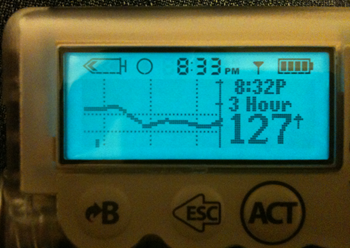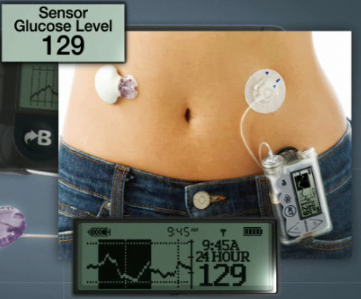UPDATE: Jay Radcliffe, the researcher discussed in this post, has emailed me, a little upset. In the interest of transparency I've included our email thread at the end of this post so that Jay's perspective on any inaccuracies may be seen. I encourage you to draw your own conclusions.
There's a story making the rounds on Twitter right now. Engadget "reports" researcher sees security issue with wireless insulin pumps, hackers could cause lethal doses.
Wait till you see what researcher and diabetic Jay Radcliffe cooked up for the Black Hat Technical Security Conference. Radcliffe figures an attacker could hack an insulin pump connected to a wireless glucose monitor and deliver lethal doses of the sugar-regulating hormone.
First, a little on my background. I've been Type 1 diabetic for 17 years. I've worn an insulin pump 24 hours a day, 7 days a week for over 11 years and a continuous glucose meter non-stop for over 5 years. I also wrote one of the first portable glucoses management systems for the original PalmPilot over 10 years ago and successfully sold it to a health management company. (Archive.org link) I also interfaced it (albeit with wires) to a number of portable glucose meters, also a first.
Engadget's is a mostly reasonable headline and accurate explanation as they say he "figures an attacker could..." However, Computerworld really goes all out with the scare tactics with Black Hat: Lethal Hack and wireless attack on insulin pumps to kill people.
Like something straight out of science fiction, an attacker with a powerful antenna could be up to a half mile away from a victim yet launch a wireless hack to remotely control an insulin pump and potentially kill the victim.
The only thing that saves this initial paragraph is "potentially." The link that is getting the most Tweets is VentureBeat's "Excuse me while I turn off your insulin pump," a blog post that is rife with inaccuracies (not to mention a lot of misspellings). Here's just a few.
- "Insulin pumps use wireless sensors that detect blood sugar levels and then communicate the data to a screen on the insulin pump."
- Way too broad. Pumps don't. Some CGMs (continuous glucose meters) communicate with special integrated pumps. The most popular integrated system is a Medtronic Paradigm. Most other CGM system have a separate "screen" device that's separate from the pump.
- "The sensor has to run on a 1.5-volt watch battery for two years."
- Nope. The Medtronic sensor needs to be charged ever 3 to 6 days. The pump battery is usually a AAA that lasts a few weeks.
UPDATE: See below email thread.
- Nope. The Medtronic sensor needs to be charged ever 3 to 6 days. The pump battery is usually a AAA that lasts a few weeks.
One useful paragraph in the VentureBeat post points out again that Jerome wasn't able to decode the message. Here, emphasis mine.
Then Radcliffe went through the process of deciphering what the wireless transmissions meant. These transmissions are not encrypted, since the devices have to be really cheap. The tranmissions [sic] are only 76 bits and they travel at more than 8,000 bits per second. To review the signal, Radcliffe captured the signal with a $10 radio frequency circuit board and then used an oscilloscope to analzye [sic] the bits.
He captured two 9-millisecond transmissions that were five minutes apart. But they came out looking like gibberish. He caputred [sic] more transmissions. About 80 percent of the transmissions had some of the same bits. He reached out to Texas Instruments for help but didn’t have much luck. He told the TI people what he was doing and they decided not to help him.
That was as far as he got on deciphering the wireless signal from the sensor, since there was no documentation that really helped him there. He couldn’t understand what the signal said, but he didn’t need to do that. So he tried to jam the signals to see if he could stop the transmitter. With a quarter of a mile, he figured out he could indeed mess up the transmitter via a denial of service attack, or flooding it with false data.
 Now, to the security issue. One has to read these articles and blog posts very carefully. It's easy Link Bait to say "A hacker can kill diabetics wirelessly without them knowing it!" (I assume we'd figure it out at some point, though.) While Jerome Radcliffe, the gentleman who did the proof of concept, is no doubt very clever, the folks who are blogging this fear mongering should do their homework and read the details. Jerome is presenting some of his findings at the BlackHat conference. Here's his abstract with emphasis mine. Note also that SCADA means "supervisory control and data acquisition." He's saying that we "cyborgdiabetics" (my term) are human control and data acquisition systems as data-in/control-out controls our health, well-being and ultimately our lives.
Now, to the security issue. One has to read these articles and blog posts very carefully. It's easy Link Bait to say "A hacker can kill diabetics wirelessly without them knowing it!" (I assume we'd figure it out at some point, though.) While Jerome Radcliffe, the gentleman who did the proof of concept, is no doubt very clever, the folks who are blogging this fear mongering should do their homework and read the details. Jerome is presenting some of his findings at the BlackHat conference. Here's his abstract with emphasis mine. Note also that SCADA means "supervisory control and data acquisition." He's saying that we "cyborgdiabetics" (my term) are human control and data acquisition systems as data-in/control-out controls our health, well-being and ultimately our lives.
As a diabetic, I have two devices attached to me at all times; an insulin pump and a continuous glucose monitor. This combination of devices turns me into a Human SCADA system; in fact, much of the hardware used in these devices are also used in Industrial SCADA equipment. I was inspired to attempt to hack these medical devices after a presentation on hardware hacking at DEF CON in 2009. Both of the systems have proprietary wireless communication methods.
Could their communication methods be reverse engineered? Could a device be created to perform injection attacks? Manipulation of a diabetic's insulin, directly or indirectly, could result in significant health risks and even death. My weapons in the battle: Arduino, Ham Radios, Bus Pirate, Oscilloscope, Soldering Iron, and a hacker's intuition.
After investing months of spare time and an immense amount of caffeine, I have not accomplished my mission. The journey, however, has been an immeasurable learning experience - from propriety protocols to hardware interfacing-and I will focus on the ups and downs of this project, including the technical issues, the lessons learned, and information discovered, in this presentation "Breaking the Human SCADA System."
Just to be clear, Jerome has not yet successfully wirelessly hacked an insulin pump.
UPDATE: See below email thread. Jerome says he can change settings and pause the pump. This may be via the USB wireless interface one uses to backup settings and send their blood sugar to their doctor. That's an educated guess on my part.
He's made initial steps to sniff wireless traffic from the pump. I realize, as I hope you do, that his abstract isn't complete. Hopefully a more complete presentation is forthcoming. I suspect he's exploiting the remote control feature of a pump. This is a key fob that looks like a car alarm beeper that some pump users use to discretely give themselves insulin doses. However, I feel the need to point out as a pump wearer myself that:
- Not every Insulin Pump has a remote control feature.
- Not every remote-controllable insulin pump has that feature turned on. Mine does not, for example.
In this AP article reposted at NPR called Insulin Pumps, Monitors Vulnerable To Hacking they give us more of the puzzle which confirms that Jerome was - in at least one hack attempt - using the optional remote control feature of the pump. A feature that few turn on. Their tech is a little off as well with talk of a 'USB device,' probably an Arduino with an RF shield.
Radcliffe wears an insulin pump that can be used with a special remote control to administer insulin. He found that the pump can be reprogrammed to respond to a stranger's remote. All he needed was a USB device that can be easily obtained from eBay or medical supply companies. Radcliffe also applied his skill for eavesdropping on computer traffic. By looking at the data being transmitted from the computer with the USB device to the insulin pump, he could instruct the USB device to tell the pump what to do.
 Finally, another piece of the puzzle is found at SCMagazine's scary "Black Hat: Insulin pumps can be hacked" article where they open with:
Finally, another piece of the puzzle is found at SCMagazine's scary "Black Hat: Insulin pumps can be hacked" article where they open with:
"A Type 1 diabetic said Thursday that hackers can remotely change his insulin pump to levels that could kill him."
ZOMG! Someone can remotely control my insulin pump? They continue...
"Radcliffe, now 33, explained that all he requires to perpetrate the hack is the target pump's serial number."
Oh, you mean the serial number that I use to pair with the transmitter to use the highly touted remote control function? This is like saying "I can open your garage door with a 3rd party garage door opener. Just give me the numbers off the side of your unit..."
What Jerome has done, however, is posed a valid question and opened a door that all techie diabetics knew was open. It is however, an obvious question for any connected device. Anyone who has ever seen OnStar start a car remotely knows that there's a possibility that a bad guy could do the same thing.
For example, literally last month I personally exchanged emails with a friendly hacker who successfully hacked the web services for the Filtrete Touchscreen WiFi-enabled Thermostat. Harmless? Perhaps, but his hack could successfully remotely control a furnace or AC in the house of anyone with this device. Any control device that's connected to the "web" or even "the air," in the case of insulin pumps, is potentially open for attack.
I appreciate the message that Jerome is trying to get out there. Wireless medical devices need to be designed with security in mind. I don't appreciate blogs and "news" organizations inaccurately scaring folks into thinking this is a credible threat.
We don't know what brand pump was experimented on, and fortunately the gentleman isn't giving away the technical details. If you are a diabetic on a pump who is concerned about this kind of thing, my suggestion is to turn off your pump's remote control feature (which is likely off anyway) and turn off your sensor radio when you are not wearing your CGM. Most of all, don't panic. Call the manufacturer and express your concern. In my experience, pump manufacturers do not mess around with this stuff. I'm not overly concerned.
All this said, I'd love to have him on my podcast. If you're reading this and you're Jerome Radcliffe, give me a holler and let's talk tech.
Of course, all this talk would be moot if we cured diabetes. In encourage you to give a Tax Deductable Donation to the American Diabetes association: http://hanselman.com/fightdiabetes/donate
Also, feel free to show people my "I am Diabetic. Here's how it works" educational video on YouTube with details on how I setup a pump and continuous glucose monitoring system every 3 days. http://hnsl.mn/iamdiabetic takes you right to the YouTube video.
UPDATE: In the interest in full disclosure, here is my email thread with Jay. As I've said, I'm happy to update the article, as am I doing here, with all perspectives. This was as much a blog post about the media and that meta-point as it was about the tech. Given that I had to piece this post together from several other posts and articles just to get an idea of what the big picture is, kind of makes my point about the problems of hyperbole in the media. Again, my concern is more about sensationalism than it is about the tech. I have no doubt a pump CAN be hacked. Any connected device can be hacked.
Here's our thread from earliest to latest:
From: Jerome Radcliffe
I *can* hack an insulin pump. I can suspend it, change all the settings remotely. I did that on stage. I'm quite disappointed that you did not verify any of the information in your article. People do die from hypoglycemia. Is it an extreme example? Yes. It needs to be. These devices need to be researched for security flaws. To talk about why someone might hack a pump misses the point.
From: Scott Hanselman
I'm sorry, I only found the articles I linked to, plus the abstract that said you hadn't. I tried to verify everything to the best of my ability to Google. Would you send me some newer links and I'll update my post? My post was meant as an analysis of the news coverage more than the attack. Send me new info?
Thanks!
From: Jerome Radcliffe
I understand your position. but as a blogger/journalist there is a certain level of responsibility to publishing facts. You come off as hypocritical blaming the media for being inaccurate on diabetics being killed by pumps, and write a piece riddled with inaccuracies on my research.
1. There is a CGM that runs on a 1.5v battery for two years. You state that my research is wrong. It is not.
2. Check CBS in las Vegas's web site. They have a video of the demo. Several media outlets reported that demo.
My name is fairly unique and my email address is easy to acquire. I would have rather you contact me for clarification rather then publish a critique of my research that is far from accurate.
From: Scott Hanselman
A random blogger and a trained journalist are certainly different things, I'm sure we can agree on. I do certainly want to improve the post and add the facts and am more than happy to do so.
I'm not sure where I said "your research is wrong" in my post, but I will re-check it. Again, most of my post is quotes from actual journalists who presumably interviewed you and I quoted them. I also quoted your black hat abstract.
I searched twitter for Jay and Jerome Radcliffe but didn't find you and wasn't able to find your blog, I suppose because of the flood of new links and stories.
This CGM runs for 2 years without recharging? Perhaps I'm confused about semantics. I've had a number of CGMs, some 1.5V and all the ones with embedded batteries needed recharging. I'll check around. Again, however, my assertion wasn't against you at all, rather the journalists whose stories were inaccurate.
I feel like we are getting off on the wrong foot here. I thought I wrote a post about how other journalists and bloggers were sensationalistic and inaccurate in their coverage. My post isn't meant as, nor should it read as, a personal attack on your hard work. As I said earlier, I'm more than happy to make updates and edits and fall on my sword with any inaccuracies. I'm even happy to post our email exchange.
Be well!
From: Jerome Radcliffe
Anytime you publish, blog or newspaper, you should be responsible for the content. There is no difference between a trained journalist and a blogger. You can't duck your own criticism of responsible reporting because you feel like your [sic] just a random blogger. The fact you are so critical of my work, you have been getting a lot of press. Your article was in the Slashdot headline, which is one of the most popular sites on the Internet. The fact is your article was highly critical of my work, and highly inaccurate. Even after I specifically told you about the inaccuracies in your writing you have not corrected them.
It's really hard for me not to be offended in this case. For the last three days I have had to answer people's questions, many have cited your article based from the Slashdot coverage.
Related Links
- Details on the 2010 Diabetes Walk and a Thank You
- Diabetes: The Airplane Analogy
- A Diabetic Product Review for Non-Diabetics - The Medtronic MiniMed Paradigm "Revel" Insulin Pump and CGM
- New integrated real-time glucose meter and pump coming THIS SUMMER
- Technology and the first insulin pump...
- Diabetics and Travelling Time Zones
- CNN: Scientists work to keep hackers out of implanted medical devices
© 2011 Scott Hanselman. All rights reserved.
